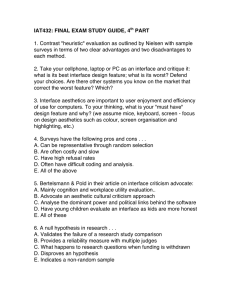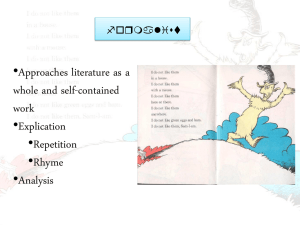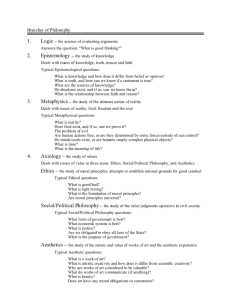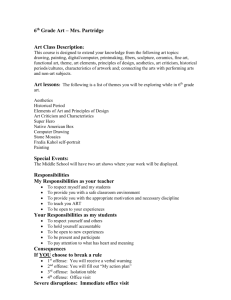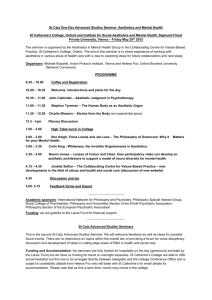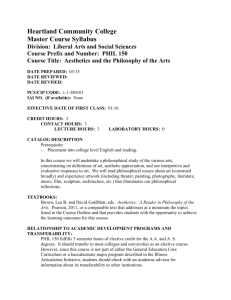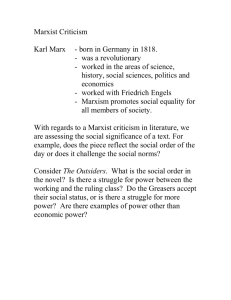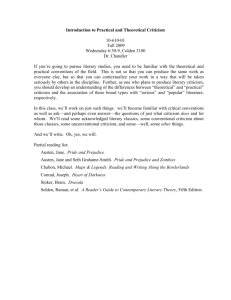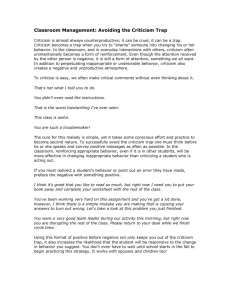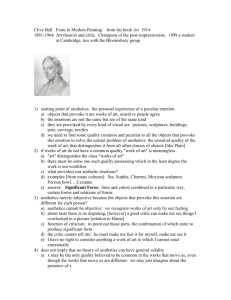Aesthetics Introduction - California State University, Long Beach
advertisement
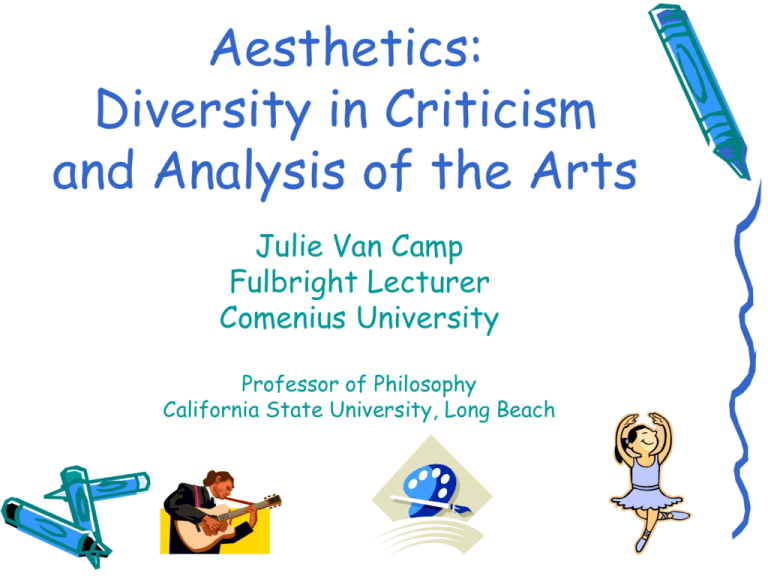
Aesthetics: Diversity in Criticism and Analysis of the Arts Julie Van Camp Fulbright Lecturer Comenius University Professor of Philosophy California State University, Long Beach Weeks 2-3 (24 Sept. & 1 October) • What is aesthetics? Critical thinking about art? • What is art criticism? • What are philosophical questions and methodologies? • How does philosophical “talk” about art differ from art appreciation, art history, and art criticism? What is Aesthetics? A set of rules or standards dictated by critics to artists Pertaining to surface or perceptual properties: "redness" "smoothness“ Philosophy of art What is Philosophy? Big picture questions Broad perspectives and interconnections Implicit assumptions: what's between the lines? Good reasoning Close examination of key terms and concepts Philosophical Questions Metaphysics: nature of reality What is real? What exists Epistemology: theory of knowledge What do we know? How do we know it? Value theory: meaning of "good" In human behavior (ethics) In art Talk About Art < Art Appreciation < Art History < Art Criticism Talk About Talk About Art Aesthetics (Philosophy of art) Weeks 4-5 (8 & 15 October) • The nature of art from different theoretical vantage points • How do different assumptions change what we see (formalist vs. expressionist vs. representation) Aesthetic Theories (Stances) Purposes < < < < < Explanation Definition of art Essence of art Characteristics or nature of art Heuristic: educate viewing public < Standards for good art Aesthetic Theories (Stances) Examples: < Representation-imitation < Expression-emotion < Communication of moral and religious ideas < Symbolic (non-verbal) communication < Formalism < Instrumentalism-experience Essentialism Search for the "essence" of art < Properties of the object (representation, expression, formalism, symbolism, etc. < Intentions of the creator < Intentions of the audience/observers Types of Aesthetic Questions Focus on: < Art works < Artists < Audience/perceivers < Context: art world/society Week 6 Midterm Exam (22 October) • You will be given an example of art and asked to discuss it from the vantage point of specific ideas to this point • Goal: to demonstrate ability to explicitly apply theoretical ideas to the analysis of art • You must write in your own words, but may refer to books and notes in developing your answer Week 7 (29 October) • Critical perspectives: • The elements of description, interpretation, evaluation/judgment • Evaluation of art: the meaning of the word “good” What is art criticism? • Art “criticism” = art evaluation • Elements of art criticism: – Description of the work – Interpretation and context – Judgment of the work • Art criticism vs. philosophy of art – Criticism: individual analysis moving toward the general – Philosophy: general moving toward the individual The Value of Art < < < < < < < < < Aesthetic value Moral value Personal value Cognitive value Economic value Practical value Religious value Political value Therapeutic value Criticism or Aesthetics? < Art criticism: Art Evaluation < Aesthetics: philosophy of art < Philosophy of art criticism Weeks 8-9 (5 & 12 November) • The significance of gender, race, and culture in art criticism • Examples: U.S. Diversity: AfricanAmerican, Latino, Asian-American, Native American • Do the U.S. experiences apply to Slovakia? How are they similar and different? Weeks 10-11 (19 & 26 November) • Teaching Aesthetics • Interdisciplinary • Active learning Learning Outcomes < Knowledge, information < Skills: philosophical inquiry/analysis, critical thinking < Attitudes, tendencies Teaching Aesthetics < Big questions chart < Philosophical puzzles < Great debates < In-out-maybe activities Leading an Aesthetics Discussion < Carefully examine key terms and concepts < Consider clarity and consistency of reasons < Make explicit the reasons or evidence that are the basis for conclusions < Consider alternative viewpoints < Hypotheticals: "what if" questions Using Puzzle Problems "Case Studies" or "Great Debates" < Avoid "yes" or "no" answers < Include "facts" supportive of both sides < Get all reasons "on the table" < Argue for a side you don't happen to agree with Week 12 (3 December) • Summary and Review • Final papers: due Thursday, 6 December (preferred: send as e-mail attachment) • Final exam: week of 7 January
